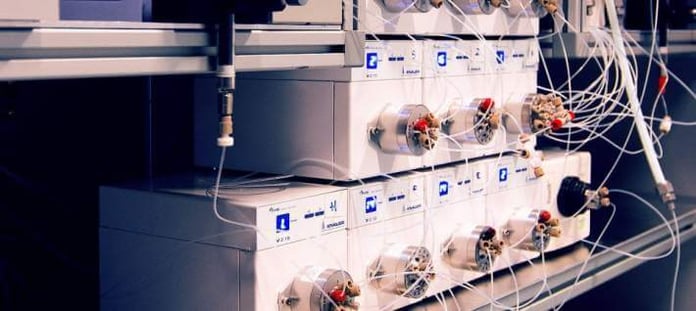
In times of the corona crisis, we got a new look at many things. This includes the possible fragility of supply chains and the question of how secure the supply of essential medicines is, the majority of which are produced in China and India. In fact, some pharmacists have already started remixing medicines themselves. Because they are in the fortunate position of having the necessary basic substances still available in sufficient quantities.
In this context, work by scientists from the Max Planck Institute for Colloid and Interfacial Research in Potsdam is becoming more topical and has now been published in the journal “Nature”. Peter Seeberger and his colleagues have developed an autonomously working chemical laboratory that could be used to produce many organic substances directly on-site, including those that are needed to manufacture medicinal substances. The researchers have already applied for a patent for the process. In the current pandemic crisis, the device will probably not be able to be used yet. This requires some optimization and numerous tests.
At first glance, the laboratory is reminiscent of a tidy cupboard in which all sorts of chemical equipment are kept. If it weren’t for the many supply lines that connect the pistons, mixers, chemical reactors, analyzers, valves, coolers, ovens, and pumps. A human being is not required to operate the laboratory, according to the researchers. Control is taken over by a computer that is also in the closet. He controls the chemical syntheses according to a defined program. He receives this over the Internet.
Chemistry at the hub
This means that nobody has to come to the equipment once it is running. Unlike other automated systems, the equipment does not have to be converted by hand, for example, to replace reactors if another material is to be produced. It was only necessary to reprogram the changed reaction conditions, such as temperature and flow rate.
The central element of the Potsdam laboratory is a turntable around which several chemical reactors are arranged. Special reactions with certain reaction mixtures take place in each. The intermediate products, which return to the turntable at the exit of each reactor, are then automatically transported to the next reactor, where they are further reacted with other reagents. In the end, after the reaction product has been separated from the solvent and subjected to a final purification, it is collected in a collecting container. Then the chemical is analyzed – also fully automatically.
“We can flexibly combine very different reactions, including fast and slow ones,” says Peter Seeberger. Unlike in conventional chemical plants with several reactors connected in series, chemical conversions that run at different speeds can be carried out efficiently here. This is a problem with linear reactor arrangements.
In order to demonstrate the ability of the self-sufficient chemical vending machine, the researchers had it produce some complex organic substances, including the active ingredient rufaminid, which is usually used against a severe form of epilepsy. Common nitrogen compounds such as ammonia, various amines, and azides were used as starting materials. The first attempts were primarily for demonstration purposes.
Now the Potsdam chemists want to test the possibilities of the chemical laboratory and produce other substances. The researchers’ vision: One day, their machine should be able to independently synthesize hundreds of active ingredients. Pharmacists would then be able to produce medication on-site – a desirable option that could also be useful in times of crisis in the future.













